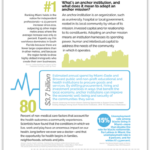WHY SHOULD HEALTH CARE SYSTEMS CARE ABOUT THE LOCAL ECONOMY?

Armed with a mountain of evidence that shows building wealth is linked to improving health, a new South Florida group sets out to do something about it.

Those of us charged with improving the health and well-being of people and communities across America are navigating what I’d call a “new era” in health care, a critical crossroad between innovation and a new way of thinking that has us looking at the root causes behind what ails us as a nation. In doing so, many working the front lines of health have reached a consensus: we cannot do it alone. Health is intrinsically tied to too many other factors — how we live, work and play to name just a few — and solutions must start prior to a patient receiving clinical care. Three years ago, administrators at a Chicago medical system came to this same conclusion and took a bold step.
Rush University Medical Center had been growing increasingly frustrated that efforts to address deep health disparities among certain residents were proving ineffective: for a staggering 70 years, the average life expectancy in low-income neighborhoods was 69, while in wealthier neighborhoods just a few miles away it was 85. Nothing they’d done — not the educational and community programs nor the interventions — chiseled away at that nagging statistic. It was time to take a different approach: they adopted an “anchor mission,” using the hospital as a powerful economic engine that could invest its resources into its surrounding community. Rush invested in the everyday factors that profoundly impact opportunities people have (or don’t have) to make healthy choices, even more so than their ability to access a doctor: job training and education, contracts for local small businesses, and nearby affordable housing developments. Soon after, they recruited other local hospitals, government agencies and nonprofits to join the anchor institution effort.
Propelled by this new purpose, the Rush administrators and their colleagues gave themselves an audacious goal: by the year 2030, cut in half the disparity gap that had for so long dodged them. They’re still on their way to doing that, of course, but what’s most encouraging is they’re not alone on the journey. In fact, Rush is among a growing number of health systems nationwide taking on similar economic development challenges, with the clear understanding that it is impossible to improve health without first building wealth and opportunity, especially for people who for too long have lacked both.
This year, South Florida is joining those ranks with the launch of the South Florida Anchor Alliance, a collaborative of regional institutions — hospitals and healthcare systems, education enterprises and municipalities — that will come together to harness their collective multi-billion-dollar spending power and vast human and intellectual capital in order to create a more just and inclusive local economy. Health Foundation of South Florida is leading the effort as the initiative’s backbone organization, thanks to support from our partners at Citi Community Development. Already, a number of regional institutions are actively engaged in exploring how to partner with the Alliance.
You might wonder how exactly a hospital would — or could — go outside the traditional boundaries of its medical services to affect something as broad and encompassing as a complex local economy. In South Florida, across Miami-Dade and Broward counties alone, public and non-profit educational and health institutions spend $3.7 billion a year procuring goods and services. Only a small percentage of that goes to small, locally and minority-owned businesses, especially those operating in historically under-represented communities. Imagine what could happen if just a small percentage of that overall spend was shifted to benefit the local economy? As has happened in other cities — such as Cleveland, where similar efforts were pioneered more than a decade ago by the area’s world-renown medical institutions — it would infuse entire sectors of our community with unprecedented capital, and it would fuel community transformation.
The true power of the South Florida Anchor Alliance lies in its members coming together to take action. While individual institutions can and do have existing initiatives and programs that benefit the communities in which they operate, it’s when they join forces to address identified opportunities that they are able to accomplish much more. Collectively, they can scale existing efforts and increase impact. They can lend their voice to an intentional conversation focusing specifically on efforts to improve health outcomes and leverage new opportunities and resources exclusively available for collective action models. Ultimately, they will gain the recognition they deserve for being leaders at the forefront of a movement to make our region healthier, stronger and more resilient.
Now, as Health Foundation of South Florida makes plans to hold the first Anchor Alliance convening this fall, where our charter members will begin to design an actionable blueprint together, we are driven by a simple, but powerful belief: that everyone in South Florida should have the opportunity to lead a prosperous and healthy life, with access to good health care, nutrition, education, employment and housing. We look forward to you joining us in this effort.

 Previous Post
Previous Post Next Post
Next Post

